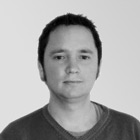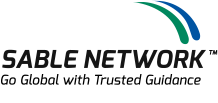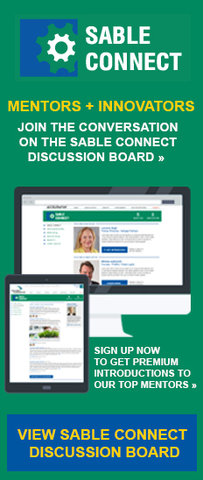expert views« Back to Expert Views Listings

Bradley Smith
Co-Founder, BusinessOptics
Bradley Smith, co-founder of BusinessOptics, was recently in San Francisco to promote his business, seek additional funding and obtain valuable feedback from experienced players in the start-up and funding industry. His ability to break down a complex approach to problem-solving, business modeling and logic mechanization is inspiring, and such a capability is characteristic of BusinessOptics, a business logic tool designed to enable businesses in their approach to answer tough questions and solve business problems.
During his visit, Smith sat down with SABLE’s Dave Kitley to provide his perspective on San Francisco’s entrepreneurial ecosystem, South Africa’s funding chasm and additional detail about BusinessOptics.
David Kitley: To kick things off, what is your elevator pitch, and why should someone use your product?
Bradley Smith: BusinessOptics helps businesses answer the questions that really matter to them, including hard questions like:
- What channels should I be focusing my marketing budget on?
- Which potential customers are most likely to buy my products?
- How can I minimize risk and maximize profit?
- With all these interrelated variables, what are the consequences of one choice over another?
BusinessOptics does this by providing a cloud-based visual modeling and predictive analytics platform that enables users to rapidly and visually express complex business logic. This enables business experts to express powerful business models that can be used to solve complex problems, learn from their past data (through integrated machine learning algorithms), compare different scenarios (with easy-to-develop interactive dashboards), optimize business and logistics decisions (through an embedded optimizer), and directly power and integrate these into their enterprise systems (through full API access). All these capabilities are presented to the user through the user-friendly mind-map interface, allowing business users to develop extremely complex models without requiring expert technical skills.
BusinessOptics provides many purpose-specific solutions and services for areas such as:
- Profit maximization for manufacturing and logistics companies incorporating demand forecasting, production planning and transport routing while ensuring business constraints are met
- Enterprise risk management for large enterprises, which includes credit risk, operational risk, insurance risk and market risk
- Predictive sales analytics to increase sales, reduce costs and manage campaign risk
- Enterprise risk management, including credit risk, market risk, operational risk and insurance risk
How was BusinessOptics conceived? What were the pain points that you observed, and what made you think you could address them?
The founders had worked predominantly in the insurance and energy industries, where there is a lot of complexity in understanding the business environment. They found that the tools business people were using to understand their environment and make decisions were inadequate in a number of ways. Tools such as spreadsheets didn’t operate at a suitable level of abstraction to deal with great complexity and broke down when dealing with complex problems. Business intelligence tools could only really do data-level analysis and could not capture the intricacies of deeper business rules. Statistical modeling tools, while powerful, were often inaccessible to business users and difficult to integrate into larger systems. ERP systems were inflexible and unable to adapt to rapidly changing business requirements.
As a result of all of these shortcomings, business users used a collection of tools to make decisions, but they could not automate these by powering their enterprise systems directly from the tools, so programmers were often called in to develop enterprise-grade solutions to implement their business logic. This created long development cycles, inconsistencies between the business vision and the actual implementation and frustration all round.
We were looking to solve complex problems in the green energy and personal finance space at web scale and realized that if we wanted to do so, we would need a tool that overcame these problems. We believed we could do this due to our burning desire to challenge the status quo and our belief in our fantastic skill set as actuaries, computer scientists, data-scientists and mathematicians. We then started building what became our product.
From this, how did you go about developing the product?
We scoped the product based on our collective business experience and vision for it. We went through extensive white-boarding and followed a path of rapid prototyping of ideas. Each feature within our product has gone through two or three iterations as a lot of the detail can only be figured out once you’ve actually played with the feature and used it in the context of solving a real-world problem. We generally kept our development pretty lean and agile, but at a number of points we made assumptions about our users and market that were not validated and later came back to bite us, most notably about a user’s willingness to invest substantial time in learning a tool as opposed to buying a solution to a specific problem.
We focused on building a platform that enabled users to build solutions that targeted specific problems on top of it, such as predictive sales analytics, rather than building these ourselves and marketing them as products. We first launched the product as a consumer-focused tool or platform, but after poor initial uptake for a number of reasons, including a non-existent marketing budget, we had to pivot in order for it to become more of a B2B product, and we built the solutions and offered professional services to help implement these.
What have been the highs and lows so far on the journey?
The highs were:
- Raising seed money initially as it was a validation of our work to date and enabled us to really dive into further product development. I must note that our angel investor has been amazing and incredibly supportive throughout the process.
- The constant release of new features built on a shoestring that make our product competitive with those available from billion-dollar companies
- Rapidly solving complex real-world business problems using our product that I had previously been unable to solve.
The primary low we experienced was the slow uptake after our initial consumer-focused release.
You recently came to America on a fundraising tour. Can you briefly describe your observations about the ecosystem and what you learned from interactions with key figures?
I found the ecosystem truly incredible. There is such a wealth of talent, and the scope of collaboration is amazing. We encountered a number of really successful and busy people who were incredibly generous with their time. The birth of so many accelerators, incubators, meet-ups, etc. is really phenomenal and is a stark contrast to the paucity of such innovation hubs in South Africa. Having said this, there are people doing amazing things on the ground in South Africa, but I think they need significantly more backing, particularly with regards to financing. I also found that the Series A crunch is very real and that it is even harsher for foreign firms looking to raise funds.
What has been your most critical business decision to date and why?
Changing from a touchless web product company to one dependent on professional services; since it’s on the back of an unknown brand, an end-to-end solution is much easier to sell than a platform.
Looking back, what have been some of the biggest lessons you have learned?
Some lessons were:
- First and foremost, keep-it-lean. Validate assumptions about your market as quickly and cheaply as possible.
- Leverage your personal network extensively for both sales leads and financing. If you have access to financing from friends and family, seek this first before seeking institutional money (particularly in South Africa) due to the time-consuming process of raising funds.
- Build a minimum viable product and ensure that business objectives drive the technical development roadmap rather than the other way around.
- Hire only the best people. Hiring a B-player is usually more detrimental to your business than hiring no one at all.
What is your take on the support provided to entrepreneurs in South Africa (government, venture capitalists, mentors, etc.), and where do you think the most critical intervention is needed?
Government is focused on investing in labor-intensive industries, and while we have investigated initiatives from the Department of Trade and Industry and other government-linked initiatives, the perceived bureaucracy led us to never pursue these options. I do believe that government could put a lot more money into bridging the gap between academia and industry as has been successfully done in other countries around the world.
Investment in angel and seed-stage companies is where I feel there is the greatest funding scarcity. To be frank, raising institutional angel or seed money in South Africa in order to build a globally competitive business is an extremely difficult and ambitious endeavor. The VCs in South Africa are actually closer to private equity firms, so acquiring money at the early stages where money is most needed is extremely difficult. We were lucky to have raised angel funding from a private investor we knew through our personal network. We’ve had incredible support from a couple of mentors and our angel investor. Without this support, we could never have gotten to where we are today. I feel that access to mentors and business networks would be the most valuable intervention that could be provided to South African entrepreneurs. There are arguments that the Broad-Based Black Economic Empowerment (BBBEE) charter provides support for this through its Enterprise Development component, but in my experience this has had little to no impact on South Africa’s entrepreneurial scene with regard to building globally competitive businesses. In terms of initiatives to provide the sort of mentorship and networks I’m referring to, SABLE is doing a fantastic job of this on a global scale, and hopefully we will start to see more such activity.
About Bradley Smith
BusinessOptics was founded by Bradley Smith, Marius van der Westhuizen and James Saunders. Smith is responsible for business development and product design. His mixed business and technical background helps guide the vision for the BusinessOptics product in a focused manner.
He previously worked within the insurance industry, building and deploying web-based enterprise resource planning systems for insurance companies in Africa.
Smith is an actuary with business science–honours degrees (cum laude) in actuarial science, statistics and computer science, as well as master’s degree in business science in the applications of machine learning techniques and risk management.
« Back to Expert Views Listings
Other Expert Views:
Q&A with Donovan Neale-May, Founder, SABLE Accelerator, CMO Council
Q&A with Kathryn Sharfman, CMO and Chief Platform Officer, Sun Exchange
Q&A with Bernard Wolfsdorf , Founder & Managing Partner, Wolfsdorf Immigration Law Group
Q&A with Pieter van Schalkwyk, CEO, XMPro
Q&A with Steuart Pennington, CEO , South Africa - The Good News
Q&A with Pumela Salela, SABLE Advisory Board Member, Global Sourcing Council
Q&A with Prof. (JD) Jonathan Jansen, Vice-Chancellor and Rector, UFS UV
Q&A with Pieter de Villiers, Founder and CEO, Clickatell
Q&A with Anthony Stonefield, Managing Director, Gramercy Millennium Group
Q&A with Pumela Salela, SABLE Advisory Board Member, Global Sourcing Council
To Become a Superstar, Improve Your Strengths (Not Your Faults), Auren Hoffman, CEO, LiveRamp
Q&A with Faheem Kajee, Co-Founder, Found (Previously Pashash)
Q&A with Jake Davidow, Founder, Teach Me Sushi and Teach Me Chocolate
Q&A with Eran Eyal, Co-founder, Springleap
Q&A with Nick McCreath, Co-Founder, Super Simple Survey
Q&A with Barry Kayton, Founder and CEO, Cognician
Q&A with Michael Leeman, Entrepreneur and Investor, RunwaySale, Gyft and Miombo Consulting
Q&A with Anita Nel, CEO: Innovation and Business Development, InnovUS, Stellenbosch University
Q&A with Laurie Olivier, Partner - 4Di Capital, Board Member and Chairman, HealthQ Technologies
What You Know Now Beats Who You Know, Auren Hoffman, CEO, Rapleaf

